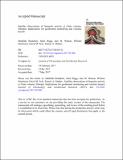Satellite observations of fumarole activity at Aluto volcano, Ethiopia : implications for geothermal monitoring and volcanic hazard
Abstract
Fumaroles are the surface manifestation of hydrothermal circulation and can be influenced by magmatic, hydrothermal, hydrological and tectonic processes. This study investigates the temporal changes in fumarole temperatures and spatial extent on Aluto, a restless volcano in the Main Ethiopian Rift (MER), in order to better understand the controls on fluid circulation and the interaction between the magmatic and hydrothermal systems. Thermal infrared (TIR) satellite images, acquired by the Advanced Spaceborne Thermal Emission and Reflection radiometer (ASTER) over the period of 2004 to 2016, are used to generate time series of the fumarole temperatures and areas. The thermal anomalies identified in the ASTER images coincide with known fumaroles with temperatures > 80 °C and are located on or close to fault structures, which provide a pathway for the rising fluids. Most of the fumaroles, including those along the major zone of hydrothermal upwelling, the Artu Jawe Fault Zone, have pixel-integrated temperature variations of only ~ 2 ± 1.5 °C. The exception are the Bobesa fumaroles located on a hypothesised caldera ring fault which show pixel-integrated temperature changes of up to 9 °C consistent with a delayed response of the hydrothermal system to precipitation. We conclude that fumaroles along major faults are strongly coupled to the magmatic-hydrothermal system and are relatively stable with time, whereas those along shallower structures close to the rift flank are more strongly influenced by seasonal variations in groundwater flow. The use of remote sensing data to monitor the thermal activity of Aluto provides an important contribution towards understanding the behaviour of this actively deforming volcano. This method could be used at other volcanoes around the world for monitoring and geothermal exploration.
Citation
Braddock , M , Biggs , J , Watson , I M , Hutchison , W , Pyle , D M & Mather , T A 2017 , ' Satellite observations of fumarole activity at Aluto volcano, Ethiopia : implications for geothermal monitoring and volcanic hazard ' , Journal of Volcanology and Geothermal Research , vol. 341 , pp. 70-83 . https://doi.org/10.1016/j.jvolgeores.2017.05.006
Publication
Journal of Volcanology and Geothermal Research
Status
Peer reviewed
ISSN
0377-0273Type
Journal article
Description
J. Biggs, I.M.Watson, W. Hutchison, T.A. Mather and D.M. Pyle are members of the NERC Centre for the Observation and Modelling of Earthquakes, Volcanoes and Tectonics (COMET). This work forms a contribution to the NERC Large Grant RiftVolc (NE/L01372X/1) awarded to J. Biggs. W. Hutchison was funded by NERC studentship NE/J500045/1. I.M. Watson is part of the NASA-ASTER science team and acknowledges NASA and JAXA for the provision of data.Collections
Items in the St Andrews Research Repository are protected by copyright, with all rights reserved, unless otherwise indicated.

